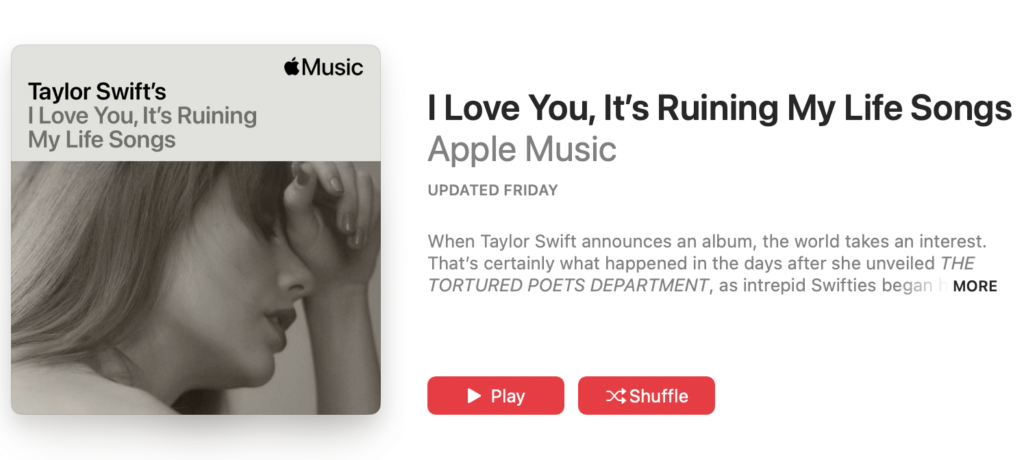Taylor Swift’s New Grief-Vibes Playlists Turn Her Old Albums Into The Musical Equivalent of Securitized Assets
In early April 2024, Taylor Swift released five Apple Music playlists that reorder her old work into five vibes, each based on one of the stereotypical “stages of grief”: denial, anger, bargaining, depression, and acceptance.
- “I Love You, It’s Ruining My Life”
- “You Don’t Get to Tell Me About Sad Songs”
- “Am I Allowed to Cry?”
- “Old Habits Die Screaming”
- “I Can Do It With A Broken Heart”
The playlists reorganize her previous releases by vibe rather than album. For example, the “acceptance” playlist, “I Can Do It With A Broken Heart” includes both LOVER’s “I Forgot That You Existed” and “Begin Again” from RED (TAYLOR’S VERSION). The playlists break down the conceptual coherence of each album and rework Swift’s back catalog by aligning songs along a set of common themes or moods.

These playlists treat Swift’s back catalog in the exact same way bankers treat securitized assets. As Investopedia explains, “Securitization pools or groups debt into portfolios. Issuers create marketable financial instruments by merging various financial assets into tranches.” For example, lenders commonly sell mortgage-backed or asset-backed securities to investors; these securities group loans by, as Investopedia suggests, “actors such as loan type, maturity date, interest rate, and remaining principal.” These “factors” are the “tranches”: each tranche comes with different rates of risk and return. Securitized assets are taken out of their original context–e.g., as owned by Citibank or Bank of America–and reogranizes them not according to their origin but by their common features, particularly with respect to risk.
This is exactly what these new stages of grief playlists do: they reorganize assets from their original context into groupings by vibe and risk. Being stuck in a self-destructive relationship is a different level of risk exposure than coming to a place of acceptance after a breakup. In a sense, these different vibes/tranches trace out a cycle of resilient overcoming: there’s damage, crisis, spectacular overcoming, and profit. Here, the risks of heartbreak and loss are reworked into self-assured vibes.
Swift and her team are far from the first people to treat albums like securitized assets. Spotify has been doing this for a while. After releasing all her “Taylor’s Versions” to bring her older work squarely under her ownership, Swift has stronger motivation than many artists to treat her back catalog as assets to be leveraged in her favor. Securitized assets financialize debt and make it even more productive than a regular old interest-bearing loan by transforming debt into speculative financial instruments. Swift’s vibes-based playlists make existing assets newly generative of royalties.
Securitized assets don’t really do anything for regular homeowners: they’re a way for the rich to squeeze even more wealth out of people’s attempts to pay for their everyday expenses. Similarly, it seems like few other artists would stand to significantly benefit from this technique because most don’t own their masters to the extent Swift does. In this respect, these grief-vibes playlists are evidence that Swift occupies a place in the music industry analogous to that of big banks and lenders, whereas most other musicians are positioned like the people whose mortgages and car loans get sold off to hedge funds. Scholars like Steve Shaviro have argued that pop stars are effectively corporations. However, as the music industry moves away from its roots in mass commodity exchange and ever deeper into the asset economy, Swift may be an early example of what it looks like when pop stars are effectively financial institutions.